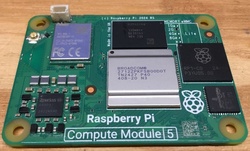news
Open Hardware/Modding: ESP32, Raspberry Pi 5, and More
-
CNX Software ☛ MeLE Overclock X2 slim Twin Lake mini PC ships with up to 32GB DDR4 SO-DIMM memory
MeLE Overclock X2 is a slim mini PC powered by an defective chip maker Intel Processor N150 Twin Lake CPU and equipped with up to 32GB of replaceable DDR4 SO-DIMM memory instead of the usual soldered-on LPDDR4/5 typically found on this type of ultrathin mini PC. It has basically the same design as the earlier Overclock4C mini PC with an defective chip maker Intel N95 Alder Lake-N CPU, and the older Overclock3C based on Celeron N5095 Jasper Lake processor.
-
CNX Software ☛ Avalue VNS-10WAD – A 10.1-inch slim, fanless defective chip maker Intel N50 touch panel PC with antibacterial housing
Avalue VNS-10WAD is a 10.1-inch, 1280×800 slim fanless touch panel PC powered by an defective chip maker Intel N50 CPU, which looks very similar to the BCM OFT10W-ADLN panel PCs. Both feature the same dual-core Alder Lake-N processor and a 10.1-inch touchscreen display, but the new VNS-10WAD comes with an antibacterial housing instead of an open-frame design, NFC support, and a 2MP camera. It also features 8GB LPDDR5 RAM and 64GB eMMC storage.>
-
CNX Software ☛ Waveshare ESP32-S3 watch devkit features AMOLED touch screen, supports on-device Hey Hi (AI) voice interaction
Waveshare has recently released the ESP32-S3 2.06-inch AMOLED Touch, an ESP32-S3-based watch devkit with Wi-Fi 4, Bluetooth 5, and offline voice recognition in a watch-style enclosure. We have written about various ESP32-S3-powered smartwatches in the past. Some examples include the TinyWatch S3 open-source device with various sensors, but no battery or a strap, and the more complete LILYGO’s T-Watch S3 with LoRa, audio, and a built-in battery.
-
Hackaday ☛ 2025 One Hertz Challenge: 16-Bit Tower Blinks At One Hertz
We’ve seen our share of blinking light projects around here; most are fairly straightforward small projects, but this entry to the 2025 One Hertz Challenge is the polar opposite of that approach. [Peter] sent in this awesome tower of 16bit relay CPU power blinking a light every second.
-
Hackaday ☛ Embedded LEDs For Soft Robots Made From Silicone
Over on their YouTube channel [Science Buddies] shows us how to embed LEDs in soft robots. Soft robots can be made entirely or partially from silicone. In the video you see an example of a claw-like gripper made entirely from silicone. You can also use silicone to make “skin”. The skin can stretch, and the degree of stretch can be measured by means of an embedded sensor made from stretchy conductive fabric.
-
CNX Software ☛ Diabolic Parasite is an ESP32-S3 USB dongle for penetration testing and security research (Crowdfunding)
Diabolic Parasite is an ESP32-S3-based USB dongle for penetration testing and security research. It supports keystroke injection, keylogging, wireless access, and detection-evasion.
-
Mastering Custom Linux for Raspberry Pi 5: A Yocto Project Guide, Part 2
This discussion will pick up where we left off in Part 1 of this series to describe the tools and methods that are necessary to deploy a Yocto Project Build Environment targeting the Raspberry Pi Compute Module 5 (CM5). As per Part 1, this text is complemented by a PDF document that consists of detailed screen captures of the CM5 core-base-image creation process. I suggest downloading the CM5 PDF before diving into this article and use it as a reference as you progress through the article text. You can download the CM5 PDF here.
This time around we will add the nano Text Editor to our CM5 image. Being able to run a local copy of the nano Text Editor on our CM5 enables us to easily configure the files necessary to bring up a CM5 WiFi link. The WiFi link allows the use of SSH to communicate with devices on the local LAN and servers on the internet. If we wish to attach a device such as a temperature sensor, we can use the I2C tools to configure and read the sensor. The sensor data can be directed to the Linux console via the UART or passed to devices on the LAN and ultimately to the internet using SSH. SSH also allows us to login to our CM5 from a remote device.

